We learn our lessons from disaster. Hurricane Andrew taught us about wind. Hurricanes Charley, Frances and Jeanne taught us about rain. The Red River of the North Basin taught us about floods. Hurricane Katrina had it all: wind, rain and flood. That we will rebuild, and rebuild in the same place, is not in doubt. This is what we do – for better or worse. If we are to rebuild and if we are to rebuild in the same place how should we rebuild?
We actually do know how to address wind, rain and flood. However, we don’t often address all three simultaneously. The lesson of Hurricane Katrina on this score is particularly harsh. Rebuilding will have to address all three.
To address wind and rain we should look to Florida. When you get hit by hurricanes on a regular basis you tend to learn a thing or two. The Florida Building Code underwent significant revision after Hurricane Andrew. The success of those changes was reflected during the four hurricanes that hit Florida during August and September 2004. No one died in any structure built under the new code changes. Furthermore, structural damage due to wind was minor in buildings built under the new code changes. And the code is being further revised as a result of the last hurricane season. Excellent guidance is readily available [1] and [2].
In an irony that is best appreciated by engineers and contractors the success of the code changes in Florida regarding wind resulted in significant unhappiness with rain entry in new buildings. When your building has blown away, when you are missing a roof and an entire façade you tend not to complain about rain leaking through walls, windows and doors. New Florida buildings did not blow away and roofs and facades stayed intact during the last hurricane season - they just leaked rainwater [3].
However, addressing rainwater entry is a rather straightforward matter [4] – but only if a decision is made to actually address it. As a result of the last hurricane season control of rainwater entry is now a Florida priority. It should be a priority everywhere it rains.
To address flood we should look to common sense:
- elevate structures;
- build with materials that can get wet;
- design assemblies to easily dry when they get wet.
The Federal Emergency Management Agency (FEMA) has all of the basics correct and has had them correct for a long time [5], [6] and [7].
The obvious point is to build up – as high as possible and practical. In coastal regions such as Charleston, SC and Florida’s panhandle the first level in new buildings is typically used for parking, storage and building access. Utilities, services and equipment are also elevated (Photograph 1 and Photograph 2). This should be the fundamental basis for construction in high flood risk areas. Farther inland, elevated crawlspaces and pier foundations can be constructed (Figure 1 and Figure 2). Slabs should be avoided. If and when slabs are constructed they should be constructed as raised slabs (Photograph 3 and Figure 3).
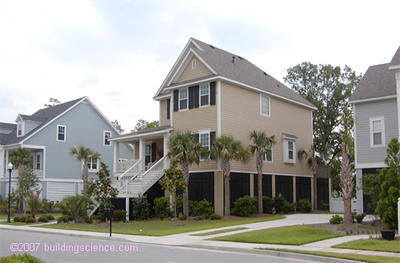
Photograph 1: New Home – Charleston, SC. First level used for parking, storage and building access.
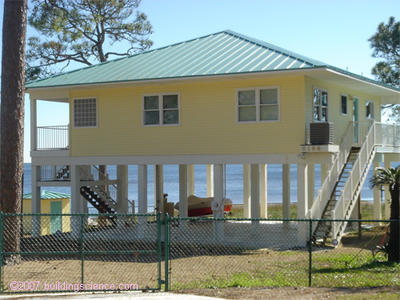
Photograph 2: New Home – Florida Panhandle. Note the location of the HVAC unit.
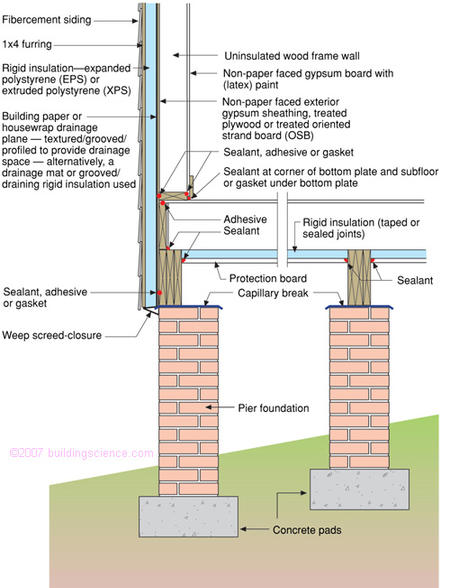
Figure 1: Pier Foundation—No cavity insulation, no water sensitive materials, assemblies designed to dry, cavities can be opened to dry after moisture event.
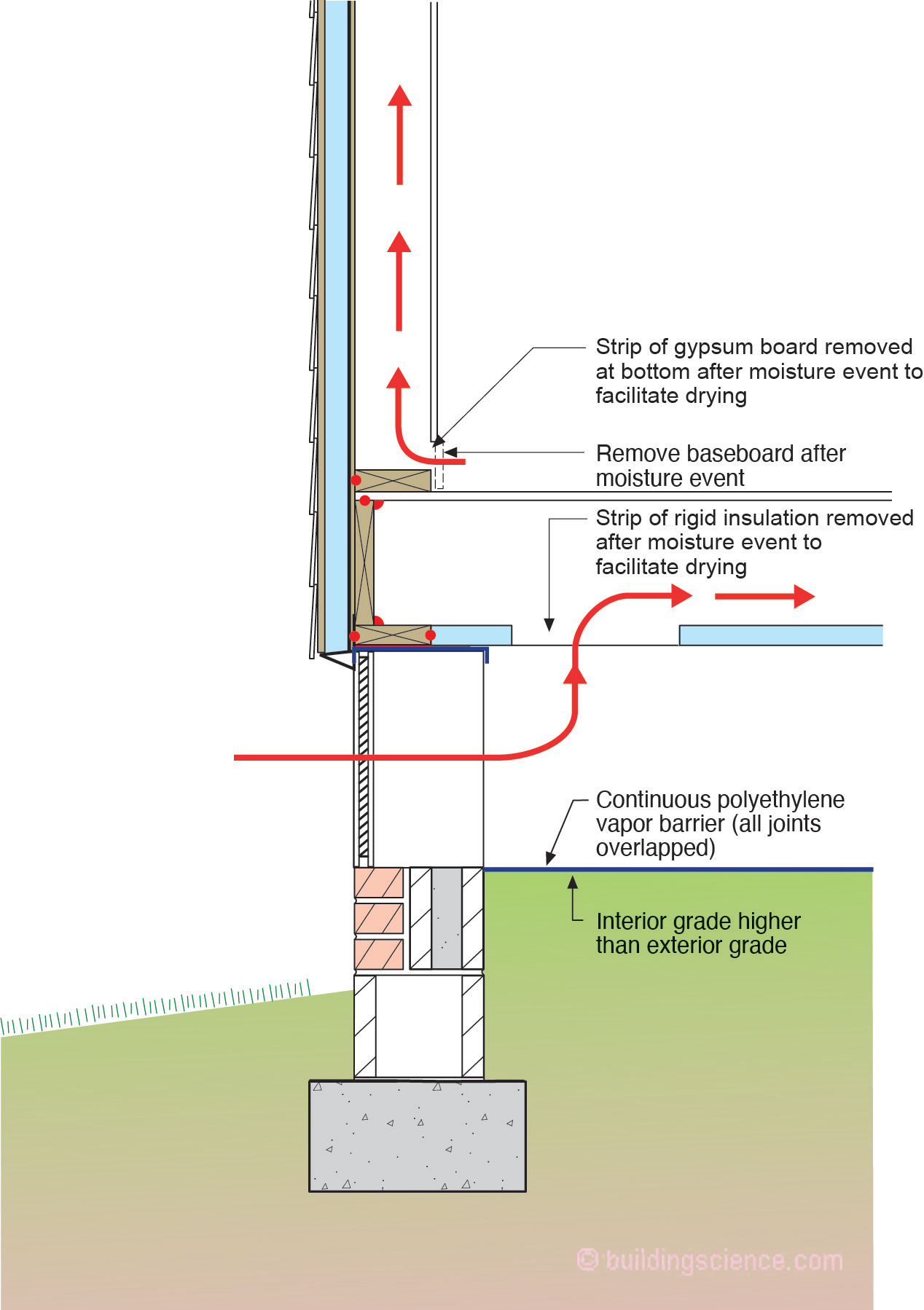
Figure 2: Elevated Crawlspace—No cavity insulation in wall or subfloor, assemblies designed to dry, cavities can be opened to dry after moisture event – note the interior crawlspace grade is above the exterior grade and crawlspace access/vents designed to “wash-out” during flood.
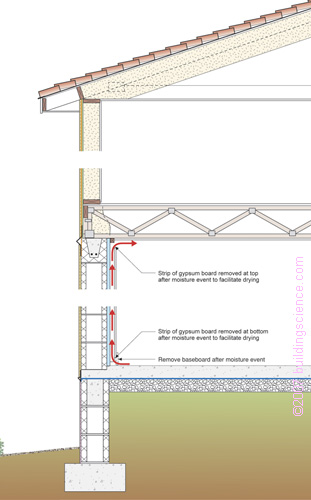
Figure 3: New Home Under Construction – Ft. Myers, FL. Note the elevated slab relative to the surrounding grade and the non-water sensitive structure (masonry wall).
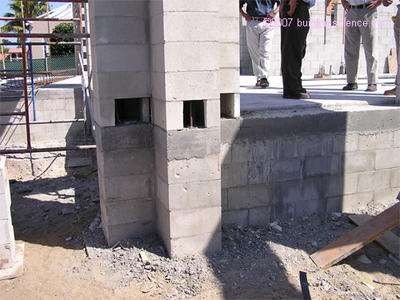
Photograph 3: Elevated Slab—No water sensitive materials on first level. Cavity insulation on second level is non-water sensitive and vapor open. Attic is conditioned and unvented reducing wind uplift forces/attic pressurization.
Additionally, we should build out of non-water sensitive materials. Again FEMA has it right [8] and [9]. Recent work has demonstrated the efficacy of constructing assemblies from water resistant materials [10]. Once again, not surprisingly, Florida leads the way. Most commercial buildings in Florida are constructed from masonry and concrete (Photograph 4).
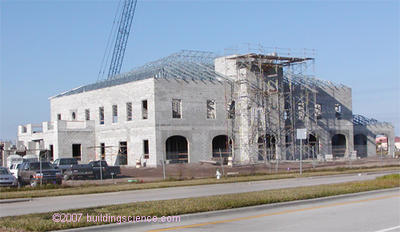
Photograph 4: Commercial Office Under Construction in Orlando, FL—The basic structure is constructed from completely non-water sensitive materials – the building has ‘good bones.'
Also in Florida, in a modern adaptation of the medieval practice of rustication residential buildings are typically constructed from masonry on the first level and wood frame on the second level (Photograph 5; see also Figure 3). In medieval times the lower level was constructed stronger to resist the marauding rabble, in modern times (in Florida) the lower level is constructed to resist the marauding water.
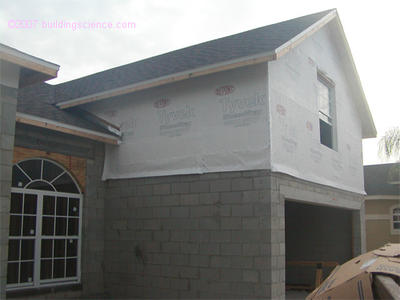
Photograph 5: Residential Rustication in Florida—The first level is masonry and the second level is wood frame.
Building with Materials That Can Get Wet
It is pretty obvious that the most water sensitive building materials in use today are paper faced gypsum board and fiberglass cavity insulation. The entire interior of a building is typically lined with paper-faced gypsum board. Our shaft walls, our utility and service walls are wrapped with paper-faced gypsum board. And in many commercial non-combustible building assemblies the exterior is also wrapped with paper-faced gypsum board. We are building paper buildings. Even the dumbest of the three little pigs didn’t build his house out of paper.
The easy answer is don’t use paper-faced gypsum board. Use non-paper-faced gypsum board on the inside of assemblies and on the exterior of non-combustible assemblies.
The answer to fiberglass cavity insulation is also equally obvious – don’t use it. In commercial steel stud assemblies do not insulate the cavity – install all of the insulation on the exterior of the assembly. And then design the cavity to be ventilated after a moisture event to facilitate drying (Photograph 6 and Figure 4). The insulation on the exterior can be semi rigid fiberglass, foam plastic boards or rock wool.
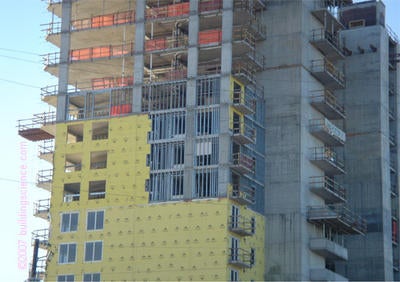
Photograph 6: Non-paper-faced exterior gypsum sheathing over uninsulated steel cavity.
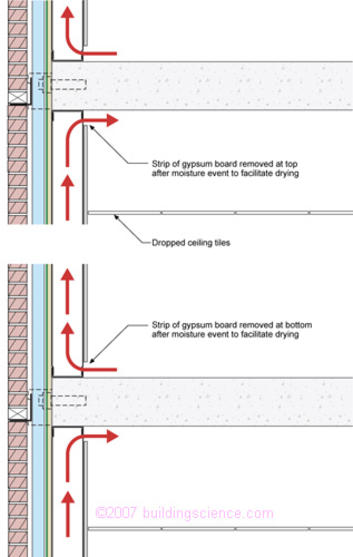
Figure 4: Uninsulated Steel Frame—Cavities are empty and can be ventilated to interior after moisture event. No moisture sensitive materials used in assemblies.
Insulating steel stud cavities has always been pretty silly anyway due to the conductivity of the steel studs. An R-19 fiberglass batt installed in a 5-1/2 inch steel frame wall yields an effective thermal resistance of approximately R-7 when insulation is installed “with good workmanship” (using the isothermal planes method – ASHRAE Fundamentals, Chapter 25). Under typical installation practice which rarely sees good workmanship the question is: “why even bother”?
I can hear the fiberglass industry lobbies and the steel industry lobbies gearing up as I write this. Folks, relax. The aftermath of Hurricane Katrina will make steel and fiberglass shine. Residential steel framing has always been a problem due to thermal bridging. When all of the insulation is on the exterior steel framing has huge advantages over wood. For one thing, rust is a lot less of a problem than mold and rot. Even better, insects don’t eat it and it doesn’t burn. What’s not to like when the cavity is empty and the insulation is on the outside? This makes even more sense commercially.
Now for the fiberglass industry: semi-rigid fiberglass has huge advantages over foam plastic insulation. It is extremely vapor permeable and will dry like gangbusters when it is on the exterior of the sheathing in a vented cavity. It also does not burn. I predict you folks can make more money selling semi rigid fiberglass exterior insulation than you can ever make selling low-density fiberglass cavity insulation. It results in a huge improvement in performance compared to current practice – plus it is flood resistant.
In commercial and residential masonry mass wall assemblies non-water sensitive semi-vapor permeable rigid foam insulation should be installed on the interior (Figure 5 and Photograph 7).
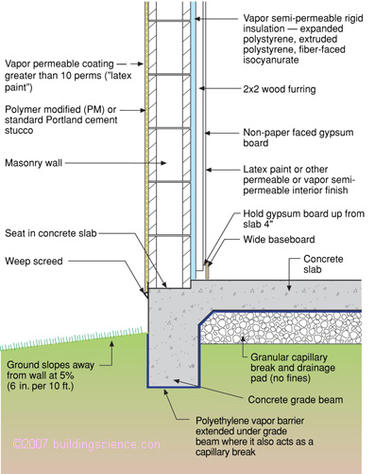
Figure 5: Masonry Mass Wall—Assembly insulated with non-water sensitive semi vapor permeable rigid foam – interior cavity designed to be opened after moisture event and ventilated.
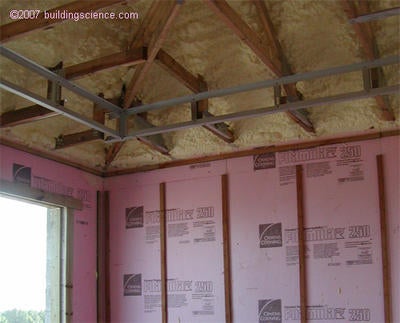
Photograph 7: Non-Water Sensitive Interior Insulation—Note the unvented conditioned attic using vapor open spray foam – conditioned attic is preferred location for HVAC system.
On exterior surfaces, wood and wood based cladding and trim materials should be avoided (Photograph 8). Fibercement and plastic composite materials should be used for exterior cladding and trim. All exterior cladding and trim should be “back vented.’ If wood trim and cladding is used (“grudgingly”) it should be coated on all six sides prior to installation to reduce water absorption.
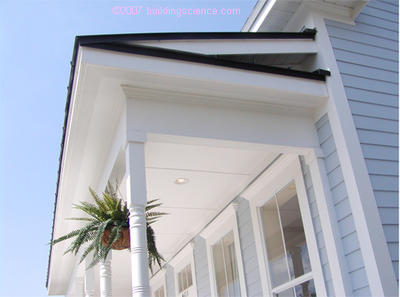
Photograph 8: Look Ma, No Wood—Non-water sensitive plastic and fiber cement exterior trim and cladding elements installed over a ventilated exterior air space (i.e. cladding is ‘back-vented’).
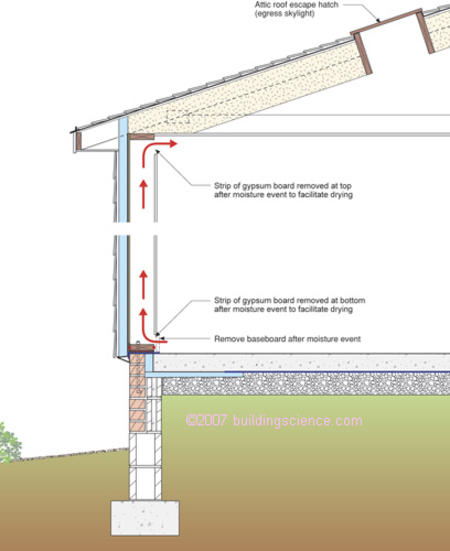
Figure 6: Exterior Insulation—Open unisulated cavity. Materials non-water sensitive. Assembly designed to dry. Egress skylight to allow escape from rising water. HVAC system in conditioned attic.
Designing Assemblies To Easily Dry
Nothing dries like airflow - especially when no power is available. Cavities should be designed to be ventilated. Interior cavities should not contain absorptive insulation – or any insulation for that matter. The interior cavities should be designed to allow vent openings to be easily provided at the top and bottom to provide ventilation airflow.
The materials themselves should be vapor open in addition to being non-water sensitive to facilitate drying by diffusion.
The “caveat” to consider is that interior vented cavities have fire consequences. Cavities should be “sealed and compartmentalized” under normal service conditions and only “opened” after a moisture event to facilitate drying.
Conclusion
The rebuilding effort after Hurricane Katrina will have to address the three principle disaster function simultaneously: wind, rain and flood. The good news is we have good experience dealing with each disaster function individually. It should be a straightforward matter to integrate the individual disaster functions.
Design and build using the following approaches:
- keep them from blowing away;
- keep the rain out;
- elevate the structures;
- build with materials that can get wet;
- design assemblies to easily dry when they get wet.
If truth be told, these approaches apply to all structures wherever they are built. We shouldn’t need a natural disaster to remind us of good fundamentals.
References
Institute For Business and Home Safety, 2005, “Fortified Builder’s Guide”, Tampa, FL.
2004 Florida Building Code, Florida Department of Community Affairs, State of Florida, Tallahassee, FL.
Lstiburek, J.W. 2005. “Rainwater Management Performance of New Constructed Residential Building Enclosures During August and September 2004, Home Builders Association of Metro Orlando and the Florida Home Builders Association Report.”
Lstiburek, J.W. 2004. Water Management Guide. Building Science Press, Westford, MA.
FEMA, 1996. Elevated Residential Structures. FEMA-54, Federal Emergency Management Agency, Washington, DC.
FEMA, 2000. Costal Construction Manual – Third Edition. FEMA-55, Federal Emergency Management Agency, Washington, DC.
FEMA, 2001. Crawlspace Construction for Buildings Located in Special Flood Hazard Areas. FIA-TB-11-01, Federal Emergency Management Agency, Washington, DC.
FEMA, 1993. Wet Floodproofing Requirements for Structures Located in Special Flood Hazard Areas. FIA-TB-7-93, Federal Emergency Management Agency, Washington, DC.
FEMA, 1993. Flood-Resistant Materials Requirements for Buildings Located in Special Flood Hazard Areas. FIA-TB-2-93, Federal Emergency Management Agency, Washington, DC.
Aglan, H., Wendt, R., and S. Livengood. 2004. “Field Testing of Energy-Efficient Flood-Damage-Resistant Residential Envelope Systems.” Oak Ridge National Laboratory, ORNL/TM-2005/34.
